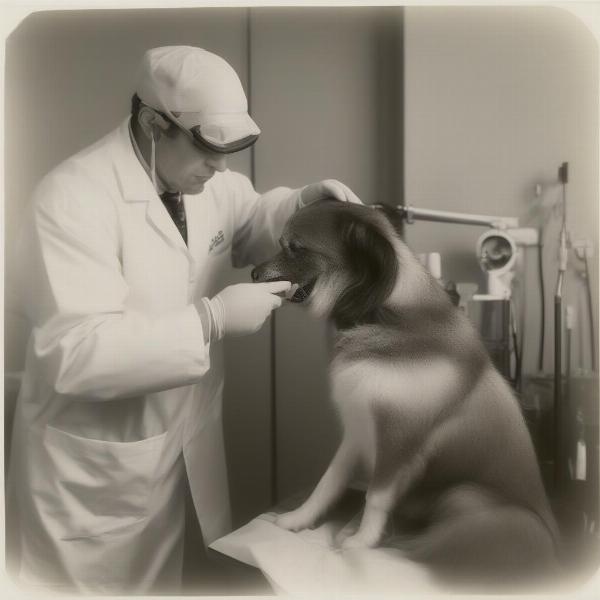Maxitrol eye drops are a common medication prescribed for dogs suffering from eye infections and inflammation. This comprehensive guide will cover everything you need to know about Maxitrol for dogs, from understanding its uses and administration to potential side effects and important precautions. Whether you’re a seasoned dog owner or new to canine care, this article will equip you with the knowledge to ensure your furry friend receives the best possible eye care.
Understanding Maxitrol Eye Drops
Maxitrol is a combination medication containing three active ingredients: neomycin, polymyxin B, and dexamethasone. Neomycin and polymyxin B are antibiotics that combat bacterial infections, while dexamethasone is a corticosteroid that reduces inflammation and swelling. This combination makes Maxitrol effective in treating a range of eye conditions in dogs.
What Conditions Does Maxitrol Treat?
Maxitrol is commonly prescribed for conditions such as:
- Conjunctivitis (pink eye)
- Keratitis (inflammation of the cornea)
- Blepharitis (inflammation of the eyelids)
- Uveitis (inflammation of the uvea)
- Post-surgical eye inflammation
Administering Maxitrol Eye Drops
Your veterinarian will provide specific instructions for administering Maxitrol, including the dosage and frequency. Generally, the drops are applied one to two drops per affected eye, several times a day. It’s crucial to follow the prescribed dosage and duration of treatment.
Tips for Applying Eye Drops:
- Wash your hands thoroughly before and after administering the drops.
- Gently hold your dog’s head still.
- Pull down the lower eyelid to create a small pocket.
- Instill the prescribed number of drops into the pocket, avoiding contact between the bottle tip and the eye.
- Close the eye gently for a few seconds to allow the medication to distribute.
- If your dog requires other eye medications, wait a few minutes between applications.
Potential Side Effects and Precautions
While Maxitrol is generally safe, some dogs may experience mild side effects such as temporary blurred vision, stinging, or redness. More serious side effects are rare but can include glaucoma, cataracts, or corneal ulcers.
 Veterinarian Examining a Dog's Eye
Veterinarian Examining a Dog's Eye
Important Precautions:
- Do not use Maxitrol if your dog is allergic to any of its ingredients.
- Do not use Maxitrol in dogs with corneal ulcers or fungal infections.
- Contact your veterinarian immediately if you notice any unusual side effects.
- Do not discontinue treatment prematurely, even if your dog’s eye appears to be improving.
dog eye drops for eye infection
Where to Buy Maxitrol
Maxitrol is a prescription medication and should only be obtained from a licensed veterinarian or with a valid prescription. where to buy maxitrol eye drops for dogs
Conclusion
Maxitrol eye drops can be an effective treatment for various eye conditions in dogs. By understanding its uses, administration, and potential side effects, you can help ensure your dog receives the best possible care. Always follow your veterinarian’s instructions and monitor your dog closely for any adverse reactions. Early detection and treatment are key to maintaining your dog’s eye health and overall well-being.
neo poly dex ointment for dogs
FAQ
- How long does it take for Maxitrol to work in dogs? Improvement is typically seen within a few days, but the full course of treatment should be completed.
- Can I use human Maxitrol eye drops on my dog? No, never use human medications on your dog without consulting a veterinarian.
- What should I do if I miss a dose? Administer the missed dose as soon as you remember, and then return to the regular schedule.
- Can Maxitrol be used long-term? Long-term use of Maxitrol can lead to side effects, so follow your veterinarian’s recommendations.
- What are the signs of an allergic reaction to Maxitrol? Signs of an allergic reaction can include facial swelling, hives, and difficulty breathing.
ILM Dog is your trusted source for expert advice on all aspects of dog care, from breed selection and health to training, nutrition, and grooming. We connect you with valuable resources and support you every step of the way on your dog ownership journey. For further assistance or to learn more about our services, contact us at [email protected] or call +44 20-3965-8624. Visit ILM Dog for more information.